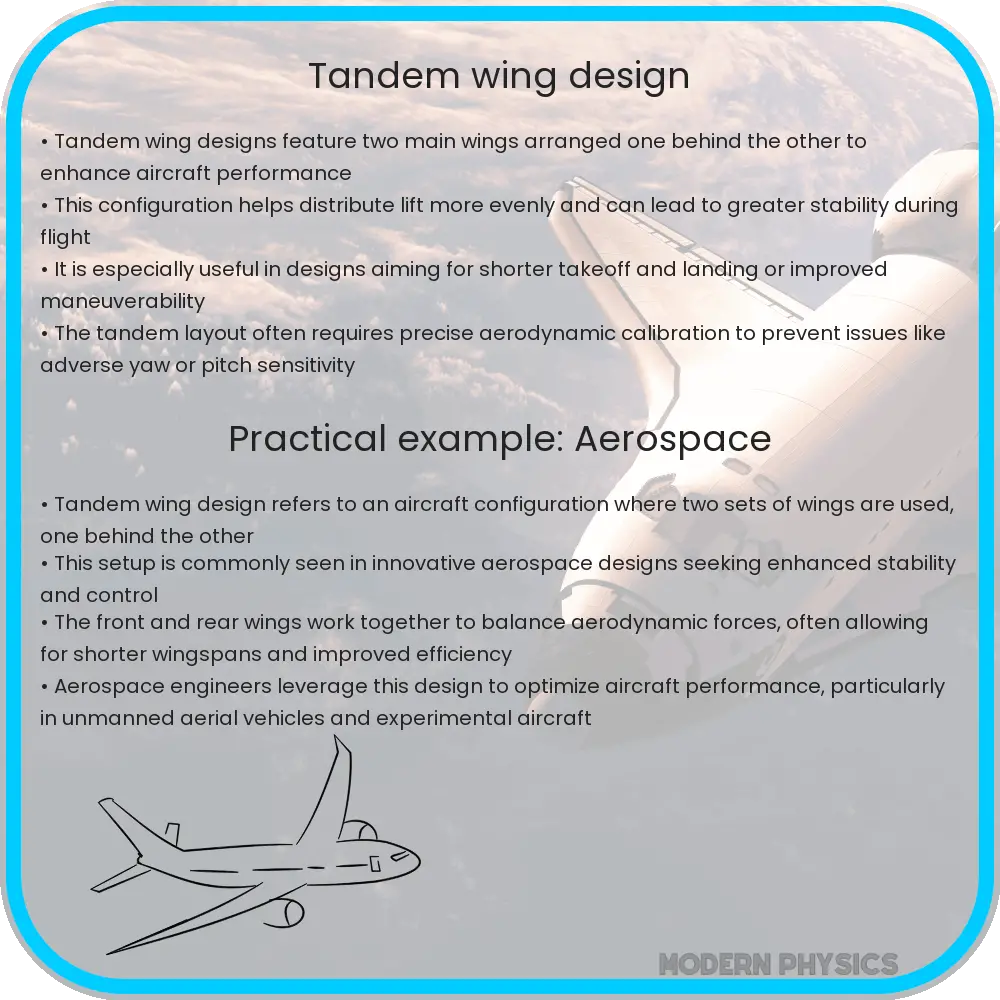A detailed exploration of tandem wing design, focusing on aerodynamic efficiency and stability in both aircraft and hydrofoil applications.

Understanding Tandem Wing Design: Efficiency and Stability
The concept of tandem wing aircraft involves a distinctive arrangement where two separate wings are fixed in such a way that one is located forward and the other aft, rather than just a single main wing as seen in conventional aircraft designs. This setup can offer unique advantages in terms of aerodynamics, efficiency, and stability, making it an intriguing subject in the field of aerospace engineering.
The Aerodynamics of Tandem Wings
In a typical tandem wing configuration, both wings contribute significantly to generating lift, but they do so in a way that also affects the aircraft’s overall aerodynamic efficiency and stability. The positioning of the wings relative to each other allows for a balancing of aerodynamic forces that can be manipulated to optimize performance.
- Efficiency: Tandem wings can potentially reduce drag significantly as compared to traditional single-wing designs. The forward wing typically directs airflow over the rear wing, which can be adjusted (in terms of angle and distance) to operate in a more optimal lift-drag ratio. This arrangement can lead to enhanced efficiency, particularly in cruising phases of flight.
- Stability: Stability is a crucial factor in aircraft design, referring to the capability of the aircraft to restore itself to a steady state after a disturbance. Tandem wing aircraft can achieve natural stability depending on the relative sizes of the wings and their distances from the center of gravity. Typically, if the forewing is smaller and set at a higher angle of attack compared to the larger aft wing, the design can yield favorable stability characteristics.
Hydrodynamics in Tandem Wing Applications
While predominantly discussed in the context of aircraft, the principles of tandem wings apply to hydrodynamic environments too, such as in underwater vehicles or hydrofoils. In these applications, fluid dynamics play a similar role to air in aerodynamics, with considerations for drag reduction and stability adjustment also prioritized.
In hydrofoil design, for example, tandem wings can help in achieving higher lift-to-drag ratios, which is crucial for speed and efficiency. By carefully designing the spacing and angle of attack between the foils, hydrodynamic balance can be maintained, enabling faster and more stable movement through water.
Next, we will delve into the mathematical model behind the lift and drag forces in tandem wing configurations and see practical examples of these theories in various aircraft and marine designs.
Mathematical Modeling of Lift and Drag in Tandem Wings
At the heart of understanding tandem wing performance is the mathematical modeling of lift and drag forces. Lift (L) is generated by the wings as they interact with airflow, and it is typically calculated using the formula:
L = (1/2) * ρ * V2 * A * CL
where ρ is air density, V is air velocity, A is wing area, and CL is the lift coefficient, which can vary depending on the wing’s shape and angle of attack. Drag (D), on the other hand, opposes the motion and is given by:
D = (1/2) * ρ * V2 * A * CD
where CD is the drag coefficient. In tandem wings, the interaction between the wings’ different aerodynamic characteristics affects these coefficients and how they contribute to overall aircraft performance.
Real-World Applications and Future Potentials
Tandem wing configurations are not just theoretical constructs but have practical applications in various sectors. Notable examples include experimental aircraft designed for increased fuel efficiency and innovative UAVs (Unmanned Aerial Vehicles) tailored for better stability in varying atmospheric conditions. Moreover, as technology in materials science advances, the potential for more optimized tandem wing designs grows, paving the way for their use in larger commercial and military aircraft.
The exploration of tandem wings is also expanding in the realm of renewable energy, particularly in wind turbines where similar principles can be applied to enhance efficiency and performance in energy generation.
Conclusion
Understanding the fundamentals of tandem wing design offers fascinating insights into a niche yet significantly potent area of aerospace engineering. By leveraging the unique aerodynamic interplay between the fore- and aft-positioned wings, engineers can devise aircraft and hydrofoil systems that excel in both efficiency and stability. As technology continues to advance, the scope of tandem wing applications is expected to broaden, possibly redefining conventional approaches to aircraft and marine vessel design. This sophisticated yet elegant configuration remains a testament to the endless ingenuity present in the exploration of aerodynamics and fluid dynamics.
